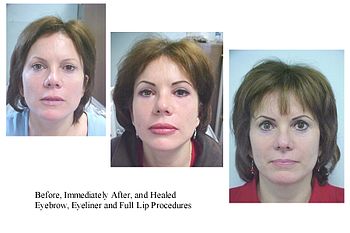This article possibly contains original research. (August 2022) |

Permanent makeup, also known as cosmetic tattooing, micropigmentation and dermapigmentation,[1] is a cosmetic technique which employs tattooing techniques to replicate the appearance of traditional makeup. By implanting pigments into the dermis, long-lasting designs are created such as eye liner, eyebrows, and lip color. This procedure appeals to a diverse range of people; from those who want to make their daily routines more simple to individuals with medical conditions. By eliminating the need to apply traditional makeup regularly, permanent makeup has become a very convenient and effective solution. More than an aesthetic technique, permanent makeup plays a crucial role in procedures of reconstructive type.
Permanent makeup has evolved from a tattooing practice to a more widely accepted, sophisticated procedure. It has become very popular, not only because of its cosmetic advantages but also for its convenience and enhancing quality of life. However, it does come with risks. Complications include allergic reactions, migration of pigment, or even infections, which underscore the importance of high-quality materials and skilled technicians.
As permanent makeup gradually gained popularity, its safety concerns, regulatory challenges, and options for removal also attracted attention. Whether selected for restoration, convenience, or other reasons, this technique represents a blend of science, personal care, and aesthetics.
- ^ Cohen, Danielle (September 27, 2024). "Everything You Need to Know About Permanent Makeup". Archived from the original on 2020-06-22. Retrieved 2014-07-18.